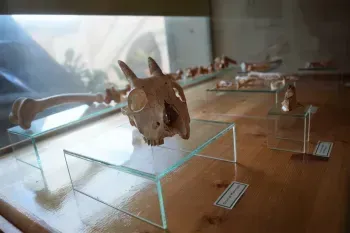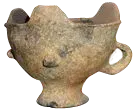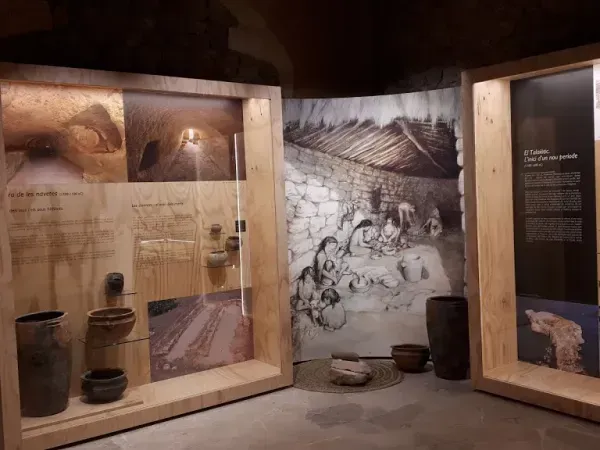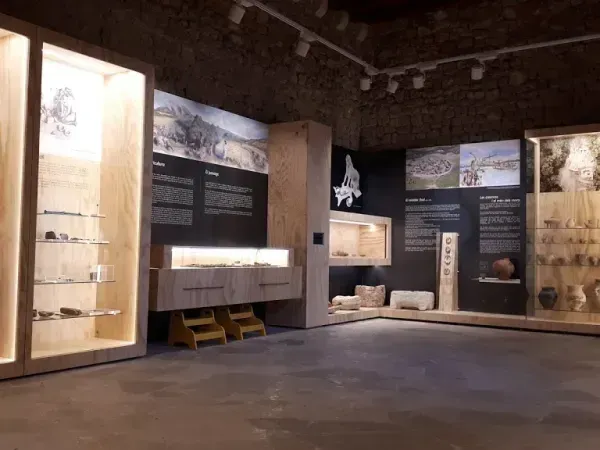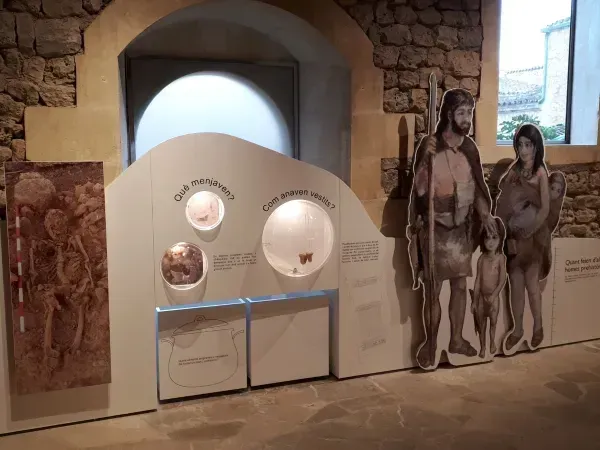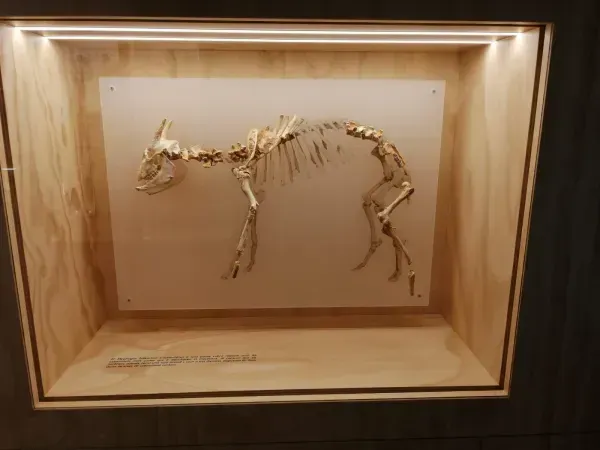The first settlers.
The first settlers arrived in Majorca 4,500 years ago, around 2500 BC.
They probably arrived from a point on the mainland somewhere between the Gulf of Lion and the Ebro Delta, from where it would have been easier to navigate to Majorca or Minorca. They brought everything with them to reproduce their way of life based on agricultural and livestock farming.
In Manacor, remains of these first inhabitants have been found in the caves and sheltered areas of the cliffs of Son Cifre, in the Sa Sínia cave and in the Bessons area.
Stone materials and incised ceramics have been found at these sites. Incised ceramics have had decorative designs cut into the clay before it has hardened, as you can see in these fragments.
The oldest human remains to date in the Ballearic islands were found in the Des Moro cave in Manacor.
Navetas (1700 ‒ 1100 BC)
Navetas are long houses with rounded ends. They are constructed using the cyclopean masonry technique, where large stones are fitted together without any mortar between them. The roof is made of wild olive tree trunks, branches, small stones, with a layer of mud to make it waterproof.
The walls are double and are inclined towards the interior. The entrance sometimes has a lintel over it. The interior of the naveta is a single room with a fireplace in the centre. It was used for resting and storing tools and food. Work and cooking normally took place at the entrance.
Navetas are often found in groups of approximately ten, although they sometimes stand alone, or in groups of three or four. In the case of Manacor, they are found in flat areas like S’Hospitalet Vell, Sa Marineta and Sa Plana, or on hills, such as at Calicant.
Little is known about beliefs during the Bronze Age. Documentation, especially from the Càrritx cave in Minorca, shows that they worshipped Mother Earth and the darkness of caves. They would have carried out religious rituals in the caves.
When a person died, their body was put into a cave with other dead people’s remains and was not covered with earth. In order to make space for new remains, other skeletons were taken apart and moved, and skulls were placed in prominent places.
Two types of cave were used for burials:
• Natural caves on inaccessible steep ground or cliffs, such as those at Cala Murada and Cala Bòta. These caves were sealed by cyclopean masonry walls.
• Caves dug into the earth with stone tools, such as those at Son Ribot or S’Homonet.
The Talayotic Period. The start of a new age (1100 ‒ 600 BC)
Around 1100 BC, Majorca and Minorca underwent significant social, political and cultural changes, marked by the abandonment of the naveta settlements. It was at this time that the small coastal headland of Sa Ferradura in Porto Cristo was occupied. Remains of a room and a large open space with traces of ten fires were found there. The whole area is enclosed by a wall made of large rocks. It seems that the area was used as a temporary refuge.
At the end of the Bronze Age, new settlements formed around a new building for communal use, the talayot. Sometimes, there were up to four or five talayots in the same settlement. There were also other constructions, such as burial mounds or tiered platforms at the settlements. At Manacor, we can see talayots at S’Hospitalet Vell, Bellver Ric, Bendrís, and the Vall de la Nou settlement, and burial mounds at Cala Morlanda and Sa Gruta.
Metal objects
During the naveta period, metal was very important. Bronze, along with its raw materials, copper and tin, originally came to the Balearic islands through exchange with other areas. Smelting moulds and ingots found at S’Hospitalet demonstrate that it was also produced on the islands. Bronze made of copper from Minorca has also been found.
A variety of metals objects dating from the Talayotic period have been found:
• Bronze human and animal figures, rings, bracelets, decorated disks, small bells, etc.
• Iron swords, daggers, spearheads, knives, etc.
• Lead plates and decorated breastplates.
Agriculture and the use of animals
Remains of food found at prehistoric sites on the Balearic Islands suggest that the population depended on agriculture and, particularly, livestock. The animals that were kept were mainly sheep and goats, along with oxen and pigs.
During the Bronze Age, the settlements at Sa Ferradura, S’Hospitalet Vell and Closos de Can Gaià in Majorca raised sheep and goats for their own consumption. However, in the Talayotic period, they raised sheep and goats to obtain wool, milk and their derivatives, but they did not kill the animals. Oxen were used to work the land because of their strength. Towards the end of the Talayotic period, chicken and horse meat began to be consumed. Curiously though, almost no fish was eaten during all of prehistory.
Not many cereals have been found at the prehistoric archaeological sites of the Balearic Islands. Perhaps it was difficult to sow the seeds, or to harvest the grain, or perhaps the fields were too remote. Even so, pollen analysis has shown that cereal crops did exist along with animal grazing areas at S'Hospitalet Vell throughout prehistory. Specifically, barley was grown there, during the time of the navetas. Wheat and barley were already being grown at Sa Ferradura, at the beginning of the Talayotic period. Similar agricultural activity took place on the Iberian Peninsula and in southern France.
The landscape and vegetation
Pollen studies carried out at La Albufera show that 5,000 years ago the landscape was similar to that of today, with wild olive trees, pine trees, mastic shrubs, rock rose, and heather, alongside fields and areas of pasture from human settlements.
In the case of Majorca, the main wood used throughout prehistory to make fire was from wild olive trees, pine trees and bushes. Carbonised remains have been found from all the periods of prehistory, along with remains of other bushes and shrubs, such as buckthorn, rock rose, heather, arbutus, rosemary, and leguminous plants. Occasionally, traces of species which are typical of humid environments, such as laurel, boxwood, yew or maple, have also been found.
Whilst during the Bronze Age, each family had collected their own wood to warm themselves, during the Iron Age the collection of wood became an activity that was done by the community.
Wood from wild olive trees was also used to build the navetas. In S’Hospitalet, a burnt roof with beams made of this wood was found. Wild olive trees also provided the most widely used wood in the Iron Age, along with pine.
Bone comparison
As you can see, prehistoric animals were smaller than present-day ones, particularly in the case of typical grazing ruminants, such as sheep, goats or cows.
This smaller size is due to a higher population and a denser occupation of the land, which must have had an impact on the quality of the pasture for the herds.
Awls
Awls were the most frequent bone instruments in the Balearic Islands during prehistory. They were used for many different jobs in leatherwork, basket weaving, carpentry, and jug making, but mainly for making holes and smoothing out materials. They were also used to weave materials and to graft plants together.
Stone objects
The stone materials that were used in prehistoric sites were almost always created from the same materials:
• Local rocks, stones and pebbles collected from around the site.
• Rocks from other parts of Majorca, such as the red Buntsandstein rocks.
• Rocks from outside the island, such as from the excavations at Sa Ferradura and S’Hospitalet Vell. As we have already seen in the case of metal, this indicates that there was a network of exchange with other territories.
The final Talayotic or Post-Talayotic period (6th to 1st Century BC)
2,500 years ago, around 550 BC, the culture that had given rise to the talayots disappeared and these constructions lost their original use. At this time, the Carthaginians founded Ibosim (Ibiza) and trade was established throughout the Mediterranean Sea.
The main social changes that took place were:
• Walls were built around villages to defend them from attacks.
• Houses became more spacious and spaces for working and resting were separated. They also incorporated a yard, a stone fireplace for cooking, and a tank to collect water.
• Slingers from the Balearic Islands participated in Mediterranean wars.
• Social differences increased.
• Burials of the dead were carried out differently according to social class.
• Sanctuaries were built as community places of worship.
Bronze figures of warriors, animals, horns, etc. have been found inside, along with accumulations of animal bones, remains of wine and traces of sacred fires associated with offerings or ritual banquets.
• The variety of ceramic and metal objects increased.
Amphoras from Ibiza, made to contain wine, stand out amongst the objects which came from abroad, which also included ceramic vessels from the Iberian Peninsula, Italy and North Africa.
• Intensely coloured glass necklace pieces made by the Carthaginians began to appear as a new characteristic product of that era.
Villages also began to change: The Punic Wars and the presence of the Romans led to fires and destruction. New products from the Italian Peninsula and new customs, such as writing and the use of money, were also introduced.
Occupation during this period has been recorded at the sites at S’Hospitalet Vell, Bellver Ric, Sant Josep, Rafalet Drac, Rafalet Vell and Vista Alegre Vell, amongst others.
Beliefs and the afterworld
During the Iron Age, burials and funeral rituals were usually held in necropolises, away from the villages, and in a number of places, such as:
• Caves, some of which had been used in previous times and others which were used for the first time, such as at Son Vaquer d'en Ribera in Manacor.
• Abandoned houses and villages, including inside talayots, in abandoned areas of talayotic settlements and inside navetas, as is the case of Coll and S’Hospitalet Vell.
• Caves carved into the rock, which are typical of the Iron Age.
• Built tombs, such as a funerary monuments or burial chambers. These are concentrated in the necropolises of the bay of Alcúdia de Son Real and S’Illot des Porros, in Santa Margalida.
Burial was constantly practised throughout the period. Corpses were bound with ropes and possibly placed in shrouds or leather.
During this period, changes were introduced in the rituals and objects that accompanied the dead. Evidence has also been found of the use of:
• Coffins, some of which had images of bulls on them.
• Biers.
• Sandstone urns with sandstone lids.
• Ceramic urns with plates as lids.
• Cut down amphoras, used as urns for children who had died in their first year of life.
• Burials in lime.
Frequently Asked Questions
How tall were people in Prehistory?
Women had an average height of 151 cm, whilst men had an average height of 164 cm.
At what age did people die in Prehistory?
Life expectancy was between 35 and 45 years for both sexes.
Many children died during their first year of life.
What did people eat?
People mostly consumed cereals and legumes, and meat and milk from goats, sheep and cows.
How did people dress in Prehistory?
We do not know very much about their clothing, but they probably wore furs and cloth, since sheep's wool had been used since ancient times. It is for this reason, that it was common to find spindle whorls and handloom weights at settlement sites, especially from the end of the Talayotic period. Bone or metal buttons and needles for clothing and hair began to be used at the time of the navetas
Glossary
Site: A place where fossils, archaeological remains, or minerals can be found.
Talayot: A square or circular prehistoric monument made with large stones, like a low tower.
Breastplate: A decorative plate, worn on the chest in ancient cultures.
Buntsandstein: Buntsandstein rocks are the oldest in Mallorca (between 246 and 251 million years old). In German, Buntsandstein means red stone.
Slinger: A soldier who used a sling as a weapon.
Necropolis: A large ancient cemetery.
Bier: A stretcher for carrying injured or dead people or weights.

